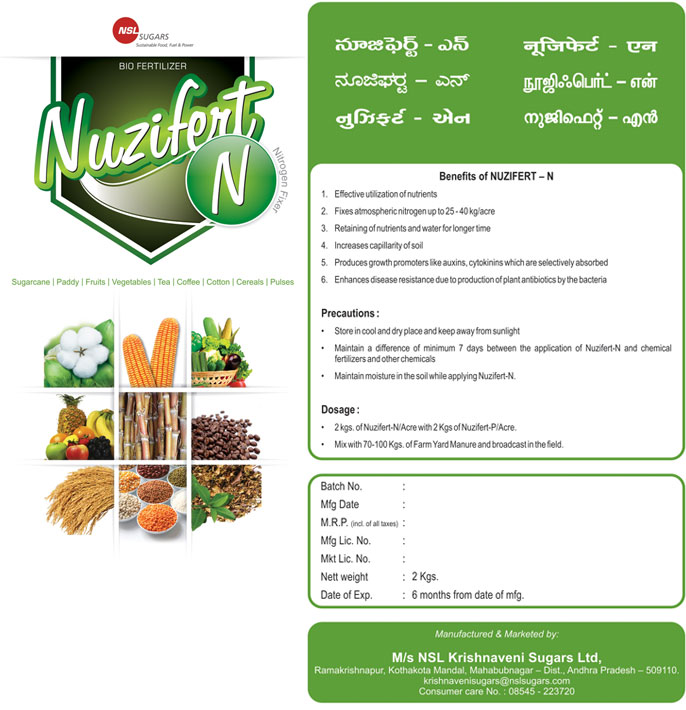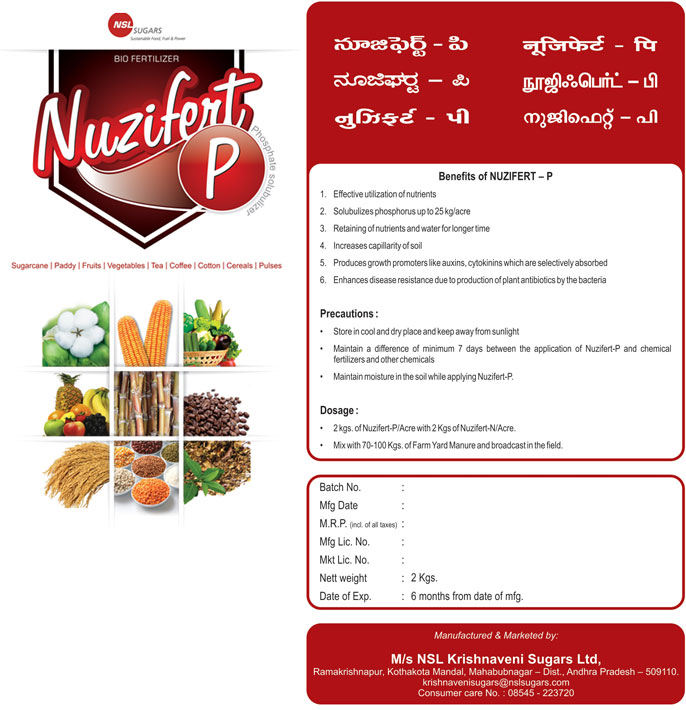Products » Bio-Fertilizers
Bio-fertilizers are defined as preparations containing living cells or latent cells of efficient strains of micro-organisms that help crop plants’ uptake of nutrients by their interactions in the rhizosphere when applied through seed or soil.
-
Advantages
- Renewable source of nutrients, Sustain soil health
- Supplement chemical fertilizers,Replace 25-30% chemical fertilizers
- Increase the grain yields by 10-40%,Solubilize and mobilize nutrients
- Improve texture, structure and water holding capacity of soil
- Stimulates plant growth by secreting growth hormones.
- Eco-friendly, non-pollutants , unhazardous and cost effective
- Suitable for crops like Sugarcane, Paddy, Vegetables & all horticulture crops.
- Increases the soil fertility.
- Increases the nutrient and water holding capacity of the soil.
- Helps in making the nutrients available to the plants.
- Helps in supplying Auxins & Cytokinins to the plants.
-
Dosages
- 4 kgs. of Biofertiliser/Acre.(2kg eah Nuzifert- N & P)
- Mix with 70-100 Kgs. of farmyard manure and is to be broadcasted in the field.
We manufactures and markets two types of Bio-Fertilizers and includes Phosphate Solubilishing Bacteria (PSB) and Azospirillum.
-
NUZIFERT - N
Bio-Fertilizer – Nitrogen Fixer
Colony forming units (cfu) - 1x108 cell/ml
Strain - Azospirillum brasilenseNUZI FERT – N fixes atmospheric nitrogen in the soil and make it available to plants. They are cost effective, eco-friendly and a renewable source of plant nutrients to supplement chemical fertilizers in sustainable agricultural systems in India. Azospirillum: Useful for high rain fall and canal irrigated soils and crops, Paddy, Sugarcane, Banana, vegetables etc.

-
Dosage
Use 15 to 20 gm / kg of seed, 2 kg for soil application per acre of land, 1 kg for root application (root dipping) of one acre of crop.
-
Uses
- Nuzifert - N helps in fixing the atmospheric nitrogen up to 25-40kg/Acre
- Nuzifert - N also helps in supplying other essential nutrients and metabolites to the plants.
- Contains useful bacteria like nitrogen fixers like Azospirillum.
-
NUZIFERT – P
Bio-Fertilizer – Phosphate solubulizer
Colony forming units (cfu )- 1x108 cell/ml
Strain - Bacillus megatheriumNUZI FERT – P is a group of beneficial bacteria capable of hydrolyzing organic and inorganic phosphorus from insoluble compounds like rock phosphate. They are cost effective, eco-friendly and a renewable source of plant nutrients to supplement chemical fertilizers in sustainable agricultural systems in India.
Useful for high rain fall and canal irrigated soils and crops, Paddy, Sugarcane, Banana, vegetables and pulses.

-
Dosage
Use 15 to 20 gm / kg of seed, 2 kg for soil application per acre of land, 1 kg for root application (root dipping) of one acre of crop.
-
Uses
- Nuzifert-P helps in solubilising the available phosphorous and makes the nutrients available to the plants.
- It coverts insoluble complex form of phosphate in to simple soluble form to increases the yield.
- Effective utilization of nutrients, solubilizes phosphorus up to 25kg/Acre
- Enhances disease resistance due to production of plant antibiotics by the bacteria
- Retaining nutrients and water for longer time
-
BIO PESTICIDES (Bio Control Agents) Pseudomonas Fluorescence
Colony forming units (cfu )- 1x108 cell/gm
Strain - pseudomonas fluorescesPseudomonas Florescens is a biological fungicide used to treat wilts, root rot in plants and loose smut in wheat. It is useful to control many kinds of fungal, bacterial, viral diseases. Many strains of pseudomonas are found in the rhizosphere of all field crops. They control pathogens by competition, parasitism and dominance. They are also known as plant growth promoting bacteria.
-
Suitable for
Sugarcane, Turmeric, Tobacco, Pulses, Oil seeds, Cotton, Vegetables, Banana, Coconut, Oil palm, Chilies, Lime, Coffee & Tea, Areca nut & Rubber, Flower crops, Spices, & Condiments’ etc.
-
Uses
It improves soil quality with subsequent uses.
- It should not be mixed with antibacterial agents and inorganic fertilizers.
- It effectively protects the plant from wilt, root rot, soft rot, blight and damping off
- It is used for control of black rot ,Rice blast and blister blight disease
-
Dosage
Use 15 to 20 gm / kg of seed, 2 kg for soil application per acre of land, 1 kg for root application (root dipping) of one acre of crop.
-
TRICHODERMA VIRIDE
Colony forming units (cfu ) - 2x10 power 6 cfu/gm
Strain - Trichoderma VirideTrichoderma Viride is a biological fungicide used as a preventive biological control agent that attacks disease pathogens before they reach the root system. It is very potential antagonistic fungus which prevents the crops from diseases viz. Root rots, wilts, brown rot, damping off, charcoal rot and other soil born diseases in crops.
-
Suitable for
Sugarcane, Turmeric,Tobbaco,Pulses, Oilseeds, Cotton, Vegetables, Banana, Coconut, Oil palm, Chilies, Lime, Coffee & Tea, Areca nut & Rubber, Flower crops, Spices, & Contiments etc.,
-
Uses
Trichoderma is able to suppress more than 60 species of pathogens (Pythium, Botritis, Phoma, Sclerotinia, Fusarium, Ascochyta, Alternaria and others) on different plants (cucumbers, tomatoes, cabbages, peppers, various ornamentals, cereals and grain legume crops).
-
Dosage
Use 15 to 20 gm / kg of seed, 2 kg for soil application per acre of land, 1 kg for root application (root dipping) of one acre of crop.
-
NUZI BIO - D (BIO - DEGRADER / BIO - CONVERTER)
Composition
Trichoderma viride - 15% Phanerochaete chrysosporium - 35% Aspergillus awamori - 10% Bacillus aporohoeus - 10% Bacillus licheniformis - 10% Rhodobacter - 10% Saccharomyces cerevisiae - 10% -
Composting
Composting is a process involving bio-chemical conversion of organic matter into humus (Lignoproteins) by mesophillic and thermophillic organisms. A composting process seeks to harness the natural forces of decomposition to secure the conversion of organic waste into organic manure.
-
Composting : Benefits
- Compost allows the soil to retain more plant nutrients over a longer period.
- It supplies part of the 16 essential elements needed by the plants.
- It helps reduce the adverse effects of excessive alkalinity, acidity, or the excessive use of chemical fertilizer.
- It makes soil easier to cultivate.
- It helps keep the soil cool in summer and warm in winter.
- It aids in preventing soil erosion by keeping the soil covered.
- It helps in controlling the growth of weeds in the garden.
- Composting of municipal solid waste with Bio- D results in clean and safe environment
- The compost produced from composting Bio- D is a kind of organic fertilizer which can be used instead chemical fertilizer
-
Dosage
1 kg / 3 MT of press mud cake







